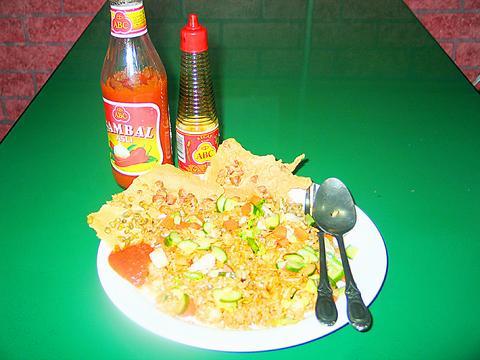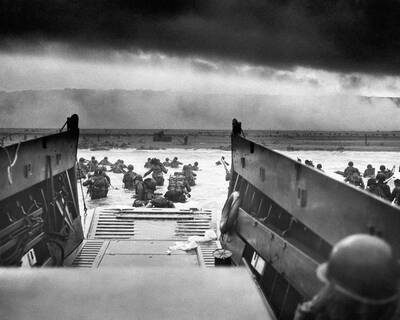Considering the popularity of Southeast Asian foods and the number of Indonesian workers in Taiwan one might expect to see a lot of Indonesian restaurants. In fact there are just a handful and few of these offer authentic Indonesian cuisine. Dede's mini-mart and restaurant fills the void with a small, but tasty selection of Indonesian fare.
An Indonesian-born Chinese, Dede moved to Taiwan four years ago to study Chinese. After having parcels of his favorite snack foods sent from home, he decided to open his own import shop on the second floor of Taipei Railway Station that would cater to the Indonesian community living in Taipei.
After a successful year he seized the opportunity to open a second mini-mart a few doors down from the Taipei Grand Mosque, catering to Taipei's wider Muslim community. This time he included a few tables and a short menu of strict Halal dishes (using only meat butchered by a Muslim).

PHOTO, DIANA FREUNDL, TAIPEI TIMES
The menu, like the surroundings, is simple, with only 11 items to choose from, but the spices used are imported and the cooking is all done by an Indonesian chef. The food can be made spicy or mild depending on individual taste, and if it's not quite spicy enough, there are bottles of sambal hot sauce on every table.
The nasi rendang sapi (beef coconut with rice) and nasi kari ayam (chicken curry with rice) are the most recommended and popular choices among regulars. The remaining options include a few seafood choices and mie (noodle) dishes. There is no vegetarian alternative listed on the menu, but the cook will prepare a enjoyable hot and spicy nasi goring sayur (vegetable fried rice) on request.
Beverages can be brought inside or purchased from the limited selection of tetra-pack juices in the cooler. In addition to all the imported Indonesian nonperishable goods and toiletries there is also an assortment of sweet and savory snack foods available at the front of the shop. The rempeyek (deep fried peanut and bean crackers) and krupuk (shrimp crackers) are great for scooping up your food or for snacking on afterward.
Indojaya Cafe and Mini-market is a no-frills environment and the food is simple, but it's clean, cheap, spicy and tastes great. There's also a KTV in the basement with possibly the largest selection of Indonesian pop songs in Taiwan.

It is jarring how differently Taiwan’s politics is portrayed in the international press compared to the local Chinese-language press. Viewed from abroad, Taiwan is seen as a geopolitical hotspot, or “The Most Dangerous Place on Earth,” as the Economist once blazoned across their cover. Meanwhile, tasked with facing down those existential threats, Taiwan’s leaders are dying their hair pink. These include former president Tsai Ing-wen (蔡英文), Vice President Hsiao Bi-khim (蕭美琴) and Kaohsiung Mayor Chen Chi-mai (陳其邁), among others. They are demonstrating what big fans they are of South Korean K-pop sensations Blackpink ahead of their concerts this weekend in Kaohsiung.

Taiwan is one of the world’s greatest per-capita consumers of seafood. Whereas the average human is thought to eat around 20kg of seafood per year, each Taiwanese gets through 27kg to 35kg of ocean delicacies annually, depending on which source you find most credible. Given the ubiquity of dishes like oyster omelet (蚵仔煎) and milkfish soup (虱目魚湯), the higher estimate may well be correct. By global standards, let alone local consumption patterns, I’m not much of a seafood fan. It’s not just a matter of taste, although that’s part of it. What I’ve read about the environmental impact of the

Oct 20 to Oct 26 After a day of fighting, the Japanese Army’s Second Division was resting when a curious delegation of two Scotsmen and 19 Taiwanese approached their camp. It was Oct. 20, 1895, and the troops had reached Taiye Village (太爺庄) in today’s Hunei District (湖內), Kaohsiung, just 10km away from their final target of Tainan. Led by Presbyterian missionaries Thomas Barclay and Duncan Ferguson, the group informed the Japanese that resistance leader Liu Yung-fu (劉永福) had fled to China the previous night, leaving his Black Flag Army fighters behind and the city in chaos. On behalf of the

The captain of the giant Royal Navy battleship called his officers together to give them a first morsel of one of World War II’s most closely guarded secrets: Prepare yourselves, he said, for “an extremely important task.” “Speculations abound,” one of the officers wrote in his diary that day — June 2, 1944. “Some say a second front, some say we are to escort the Soviets, or doing something else around Iceland. No one is allowed ashore.” The secret was D-Day — the June 6, 1944, invasion of Nazi-occupied France with the world’s largest-ever sea, land and air armada. It punctured Adolf